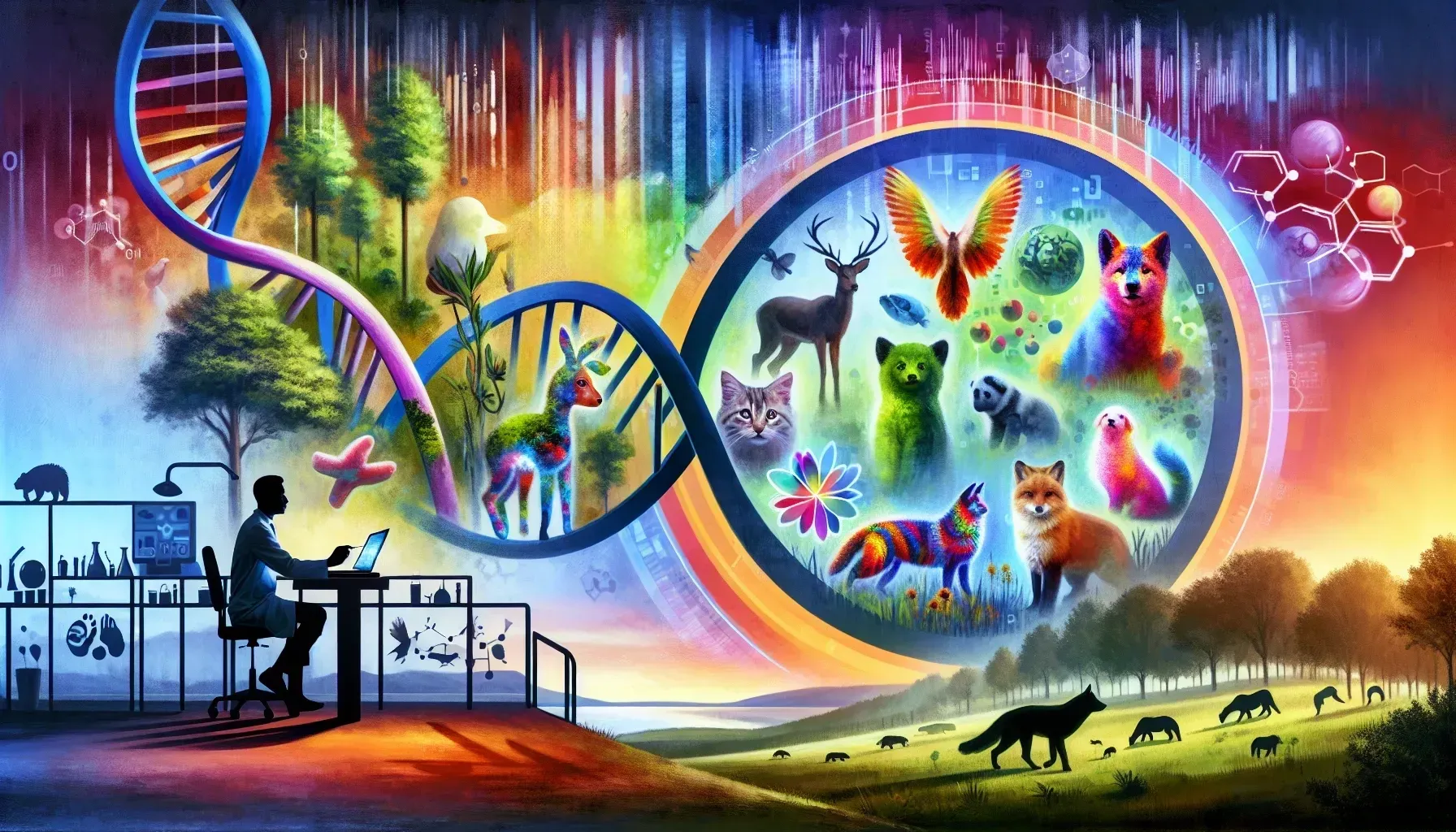Reimagining Conservation Through Biotech in Pets: Where Do We Draw the Line?

The integration of biotechnology in the pet care industry is reshaping the landscape of pet companionship. What once seemed like a concept reserved for science fiction has transcended into reality, as biotechnological advancements are altering the genetic makeup and physical attributes of pets. From hypoallergenic cats to fluorescent fish, these genetically modified organisms have moved from laboratories to become beloved members of households worldwide.
The Journey of Biotechnologically Enhanced Pets
Biotechnologically enhanced pets represent a fusion of innovation and companionship. Through biotech, pets are not only being bred for endearing qualities but also for genetic traits that ensure better compatibility with their human caregivers. These advancements raise intriguing questions about the implications of engineering pets to cater to specific human needs and preferences. As technology progresses, such advancements are likely to become more accessible, sparking a transition from traditional pet breeding practices to advanced genetic engineering in the living rooms of pet owners.
The pursuit of creating aesthetically pleasing biotech pets brings attention to the potential conflicts between genetic modification for beauty and the preservation of biodiversity. While biotech beauty can foster public interest in conservation efforts by encouraging appreciation for unique and visually striking organisms, it also poses challenges to the preservation of natural biodiversity within ecosystems. As pet enthusiasts increasingly favor genetically modified pets with eye-catching features, there is a need to balance the promotion of biotech beauty with a commitment to preserving the natural diversity of species in their native habitats.
Balancing Aesthetics and Ecosystem Integrity in Biotech Pets
Understanding the ecological impacts of introducing biotechnologically enhanced pets into the ecosystem is crucial. It prompts a critical examination of how these engineered organisms interact with native species and the potential repercussions on ecological balance. As the trend towards biotech beauty gains momentum, it is imperative to consider strategies that uphold both aesthetic appeal and ecosystem integrity, ensuring that conservation efforts are not overshadowed by a singular focus on creating visually alluring pets.
The emergence of biotechnological solutions in pet care prompts reflection on whether these innovations serve as genuine contributions to conservation or merely function as cosmetic remedies masking larger environmental issues. While biotech solutions offer tangible benefits such as mitigating allergic reactions and promoting responsible pet ownership, they should not divert attention from pressing environmental challenges that demand comprehensive conservation efforts.
Related Article: Conservation Companions: Multidisciplinary Teams Tackling Wildlife and Pet Preservation Together
Are Biotech Solutions Masking Larger Environmental Issues?
It is essential for pet owners, industry stakeholders, and conservation organizations to maintain a holistic perspective that extends beyond the allure of biotechnological enhancements. By acknowledging larger environmental imperatives and addressing systemic issues threatening biodiversity and ecological integrity, the pet care community can ensure that biotech solutions align with broader conservation goals rather than serving as superficial fixes for deeper environmental concerns.
The prospect of cloning beloved pets through biotechnology raises profound ethical considerations that warrant careful examination. While cloning technologies offer an avenue for replicating cherished animal companions, they also evoke ethical concerns related to individuality, welfare, and psychological impact on both cloned animals and their human companions.
Delving into discussions about cloning pets necessitates evaluating the well-being of cloned animals and addressing ethical dimensions linked to their quality of life. Furthermore, considerations extend to understanding the emotional facets associated with pet loss and whether cloning truly encapsulates the essence and uniqueness of individual animal companions. As biotechnological capabilities advance, navigating ethical boundaries surrounding pet cloning becomes increasingly pertinent, emphasizing the importance of deliberative conversations on responsible applications of cloning technologies in the context of pet care.
The Ethical Implications of Cloning Our Beloved Pets
The advent of designer DNA in pet care heralds a new era where genetic modification enables tailored traits and characteristics in companion animals. While this innovation offers opportunities for enhancing pet welfare by mitigating hereditary health conditions and predispositions to diseases, it also raises ethical considerations regarding potential alterations in natural genetic diversity and the long-term consequences of manipulating genetic codes.
Assessing genetically modified pets entails recognizing how designer DNA influences animal welfare and considering implications related to species authenticity and genetic diversity maintenance. Encouraging informed discussions on genetically modified pets involves weighing the benefits against potential drawbacks, prioritizing animal welfare over cosmetic enhancements, and ensuring that genetic modifications align with ethical standards that safeguard both individual animals and broader species integrity.
Related Article: Beyond Boundaries: Nicole Jenkins' Global Influence in Promoting Exotic Animal Welfare
Designer DNA: Innovation or Interference in Pet Care?
Biotechnology presents prospects for safeguarding at-risk species from extinction through methodologies such as assisted reproductive technologies, gene editing, and genomic preservation. While these advancements offer hope for reversing population declines and restoring genetic diversity in endangered species, they also necessitate deliberation on ethical considerations related to intervening in natural evolutionary processes and potentially disrupting delicate ecological dynamics.
As discussions surrounding biotech interventions for at-risk species unfold, it becomes imperative to navigate ethical landscapes with a comprehensive understanding of ecological repercussions and long-term viability assessments. Embracing these technological advancements requires careful scrutiny to ensure that conservation efforts prioritize maintaining ecological balance while serving as responsible measures aimed at alleviating threats faced by endangered species.
The Promises and Perils of Biotech for At-Risk Species
The portrayal of biotechnologically enhanced pets as conservation heroes accentuates narratives surrounding technological interventions aimed at preserving biodiversity. Leveraging these pets as ambassadors for conservation enables engagement with diverse audiences and fosters awareness about wildlife conservation challenges through relatable, genetically modified animal ambassadors.
By highlighting the roles played by biotech pets in fostering environmental consciousness, it becomes possible to bridge connections between domesticated animals and broader conservation initiatives. Nevertheless, representing biotech pets as conservation heroes warrants careful consideration regarding messaging authenticity, transparency about genetic modifications, and alignment with broader conservation strategies focused on protecting natural habitats and wild populations.
As public interest in bioengineered pets continues to grow, diverse perspectives emerge regarding their societal acceptance, cultural significance, perceived value, and ethical dimensions. Unpacking these perspectives involves recognizing variances in public attitudes towards bioengineered pets while underscoring informed discussions that address misconceptions through education about scientific principles underpinning bioengineering technologies.
Related Article: Transformative Tales of Animal Advocates: Elevating Animal Welfare Across the Globe
Should Biotech Pets Be Conservation Role Models?
Fostering dialogues surrounding bioengineered pets facilitates an environment where prejudices are dismantled through open exchanges that promote nuanced understandings encompassing scientific progress, ethical considerations, animal welfare prioritization, and societal perceptions pertaining to genetically modified companion animals across diverse cultural landscapes.
Engaging eco-ethicists holds pivotal significance in harmonizing biotechnological advancements with ecological wisdom within the realm of pet care. Their perspectives provide critical insights into aligning biotech innovations with ecologically sustainable practices while safeguarding biodiversity through responsible utilization of genetic engineering technologies.
Frequently Asked Questions
Biotechnologically enhanced pets are animals whose genetic makeup has been modified through biotechnology. This can include traits like hypoallergenic fur or unique colors, making them more appealing to pet owners. These innovations aim to improve compatibility with human caregivers and enhance the overall pet ownership experience.
Biotechnology can significantly impact biodiversity by creating genetically modified pets that may compete with or replace natural species. While these pets can attract interest in conservation, they also pose risks to ecosystem integrity, highlighting the need for a balance between aesthetic appeal and the preservation of natural species diversity.
Biotech solutions, while beneficial, may distract from larger environmental challenges that require comprehensive conservation efforts. Focusing solely on genetic modifications for pets can lead to neglecting critical issues like habitat destruction and climate change, which threaten biodiversity and ecological health.
Cloning pets raises ethical concerns regarding individuality and animal welfare. Cloned animals may face health issues and lack the unique traits of their original counterparts. Additionally, the emotional implications for owners coping with loss must be considered, as cloning may not truly replicate the essence of their beloved pets.
Yes, designer DNA can enhance pet health by addressing hereditary conditions and reducing disease susceptibility. Genetic modifications can lead to healthier pets with longer lifespans. However, it is essential to weigh these benefits against potential risks to genetic diversity and the ethical implications of such alterations.
Biotechnology offers methods like gene editing and assisted reproduction to help endangered species recover from population declines. These technologies aim to restore genetic diversity and improve survival rates. However, careful consideration of ecological impacts is crucial to ensure these interventions do not disrupt natural ecosystems.
Biotech pets can serve as ambassadors for conservation by raising awareness about biodiversity challenges. By showcasing genetically modified animals, they engage the public's interest in wildlife preservation and foster discussions on ecological responsibility, bridging the gap between domesticated animals and broader conservation initiatives.
Public perceptions significantly influence the acceptance of bioengineered pets. Misconceptions about genetic modifications can lead to prejudice against these animals. Promoting informed discussions that clarify scientific principles and ethical considerations is essential for fostering a better understanding of bioengineered companion animals in society.
Eco-ethicists emphasize the importance of aligning biotechnological advancements with ecological sustainability. Their insights advocate for responsible use of genetic engineering technologies while safeguarding biodiversity, ensuring that innovations in pet care do not compromise environmental integrity or disrupt natural ecosystems.
Yes, there is a risk that creating genetically modified pets could lead to a reduction in natural genetic diversity. As certain traits become favored through biotechnology, less attention may be given to preserving traditional breeds and wild relatives, potentially jeopardizing the overall health of various species.






